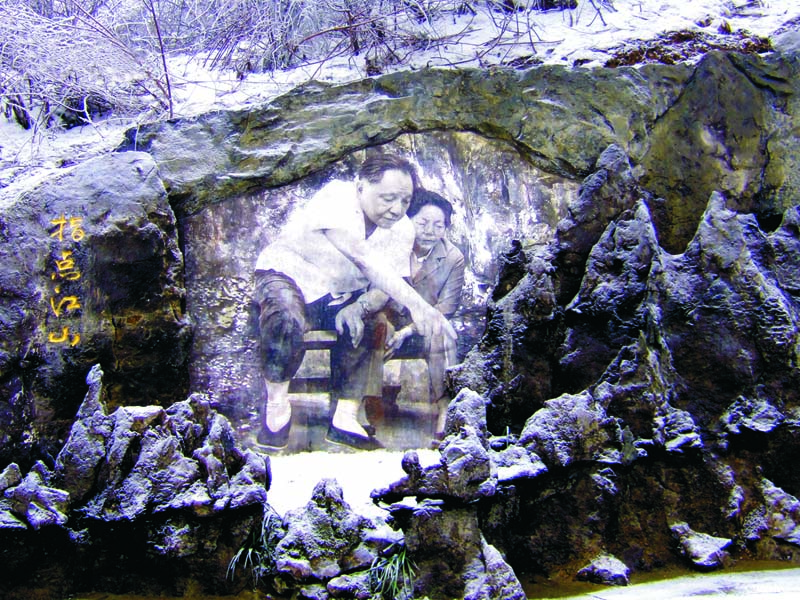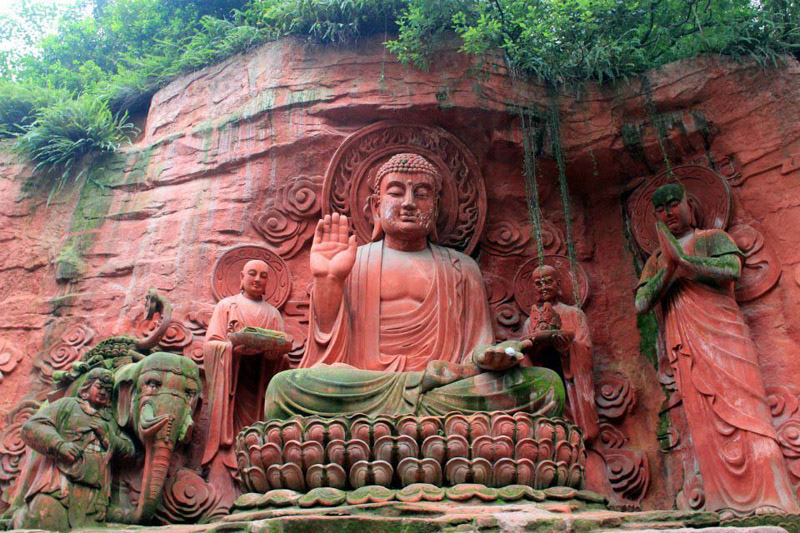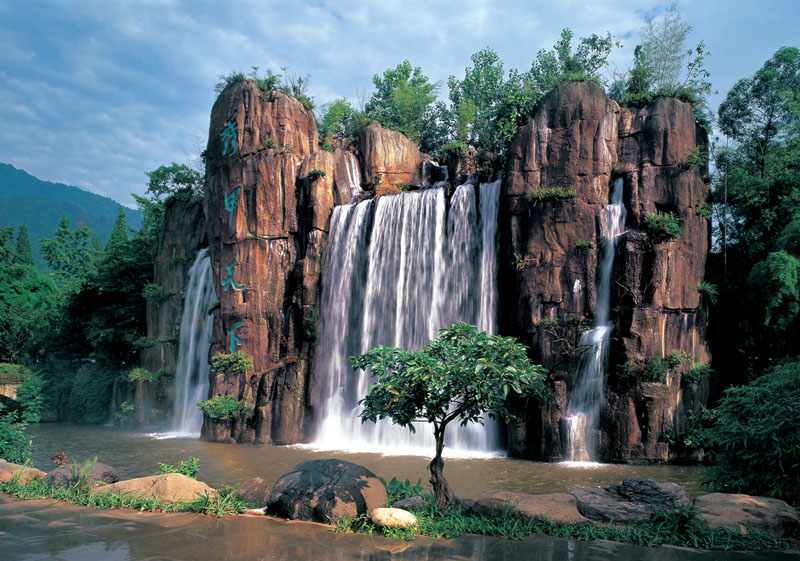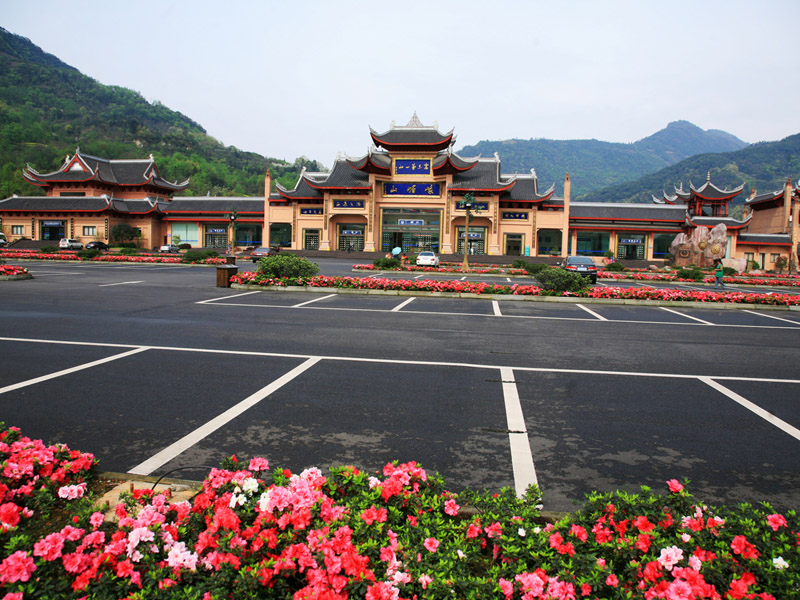Newly-developed Top 10 Attractions
In recent years, new Top 10 Attractions have been developed in order to promote the historical and cultural heritages of Mt. Emei. The 10 attractions include Gold Buddha on the Golden Summit, Ringing Bells on the Wanfo Summit, Memory of Deng Xiaoping, Qingyin Lake, Monkeys in the Valley, First Mountain Pavilion, Cliffside Carvings, Xiujia (Most Beautiful) Waterfall, Guest Greeting Square and Starting Point of the Mountain.
Gold Buddha on the Golden Summit
The Golden Summit is the symbol of Mt. Emei, and the Gold Buddha is the symbol of Mt. Emei. You cannot say you have been to Mt. Emei if you haven't been to the Golden Summit; you will be full of regret if you haven't worshiped the Gold Buddha on the Golden Summit! Golden Summit, where various scenic spots and temples meet, represents the harmony between human and the nature and the integration of Samantabhadra Bodhisattva's actions and wishes and the people's wishes. The 48-meter-high four-face and ten-direction golden Samantabhadra statue on the Golden Summit, absorbs the best from the heaven and the earth and reflects the brilliance of the sun and the moon. It observes the secular life of the people and makes their wishes come true. Graceful Samantabhadra Bodhisattva sits upright on a lotus stage supported by three elephants, still, compassionate and peaceful, with clouds and mists surrounding his body. When rays of sunlight shine atop the statue, auspicious light is reflected from the gold Buddha, embroidering the clouds sea with gold edges, stirring the souls of the mortal beings, who willingly prostrate themselves in worship. Facing the gold Buddha, the mind is cultivated, blessing is obtained, and the mortal beings' wishes may be realized.

Ringing Bells on the Wanfo Summit
The peak of Mt. Emei, Wanfo Summit, named after the saying that "where Samantabhadra Bodhisattva's resides, ten thousand Buddhas (meaning wanfo in Chinese) are surrounding", is at an elevation of 3099 meters. It is one of the primeval forest eco-tourism zones in Mt. Emei, where Wanfo Temple, Alpine Azalea Forest, Black Bear Valley, The Immortal Turning Around and other scenic spots locate. The stately Wanfo Temple is 21 meters high, with a solemn bell hanging in its attic. There are rules on striking the bell in Wanfo Temple. Normally, the bell should be striken for 108 times. Eighteen rapid strikes, eighteen slow strikes and eighteen neither-rapid-nor-slow strikes make up a round, and one round should be performed both at dawn and dusk. Two rounds, equally 108 times of strike, per day represents 12 months, 24 solor terms and 72 pentads in a year. 108 times a round represents the come and pass of a year, implicates the wishes for the everlasting and a prosperous as well as peaceful country.It is also known in Buddhism that striking a bell for 108 times may relieve 108 kinds of worries and distracting thoughts. Facing the Gold Buddha, and striking the bell in Wanfo Temple on the extreme top of Mt. Emei enables you to knock at the gate of the Pure Land and deliver your wishes.

Memory of Deng Xiaoping
In the summer of 1980, Deng Xiaoping, the Chief Architect of China's reform and opening up and the then Vice-Chairman of the Central Committee of CPC, inspected Mt. Emei. When he stopped at Shuangshuijing, the end of the highway of the scenic area at that time for a rest and looked into the distance. Faced with the beautiful views of Mt.Emei, comrade Deng Xiaoping said vigorously: "Mt. Emei is a scenic area with rich culture. It's a treasure chest that needs to be well protected, planned and developed comprehensively. The construction and management should be enhanced, and the spirit of never stop should be executed!" In order to commemorate this great man, a memorial pavilion was constructed here. This attraction is made up of the Monument, Love between Fish and Water, Conducting State Affairs and Never Stop Climbing.

Qingyin Lake
Qingyin Lake is one of the representatives of natural views in Mt. Emei. It is situated in the Qingyin Temple scenic zone, covering an area of 300,000 m2. With pure and limpid water, it is an ecological lake. Surrounded by lush green mountains and towering ancient trees, the lake resembles a jade embedded into the background, offering a vast expanse of luxuriant green. With dense shades of green trees, sounds of cicada, and gusts of mountain wind, the lake washes off the dirt of the mortal world, presenting a leisure space with attractive natural views. It is cool here in both summer and autumn, which makes it to be a summer resort. Even in winter and chilly early spring, it is still warm here without cold winds, and the plants and trees here are still green.

Monkeys in the Valley
Monkeys are angels in Mt. Emei. They are naughty, naive and smart. Rather than afraid of human beings, they love to play with people. Having brought so much fun to tourists, the monkeys are a dynamic attraction in Mt. Emei. It is an indispensable part of touring Mt. Emei to play with and feed the monkeys, to observe and learn about their habits, and to have an intimate contact with them. The Ecological Monkey Zone is situated in the Qingyin Temple scenic zone, between Yixiantian and Hongchunping. Being a long and narrow valley, it is the largest natural ecological monkey conservation area in China, with an area of 25 hectares. Currently, there are three families of wild monkeys in the zone, totaling over 300 monkeys.

First Mountain Pavilion
First Mountain Pavilion, located in the low-elevation scenic area, is the largest brass pavilion in China. It is also the start point of the touring route to the mountain. After passing the Tianxia Mingshan (famous mountain under the heaven) Arch, tourists will firstly notice the stately First Mountain Pavilion, with the three Chinese characters Di Yi Shan (means first mountain) shining atop the pavilion. The Pavilion is 16.1 meters high, and its double eaves appear to curl up at the edges, looking exquisite, stately and splendid.
The First Mountain Pavilion demonstrates not only the rich culture of Mt. Emei, but also the grandness of the mountain. There are four pairs of couplets praising Mt. Emei written by famous Chinese calligrapher inside the Pavilion. These descriptions about Mt. Emei are quoted from classics including Avatamsaka Sutra and Classic of Mountains and Seas, and prove Mt. Emei's important position in China's famous mountains, Buddhism and Taoism.

In the middle of the Pavilion stands the brass statue, the precious stone supported by a lotus. The statue is made up of three components: a precious stone, a lotus and a base. The precious stone is made up of a glittering and translucent crystal, with copper-cast Chinese characters meaning "World's Heritage" and "National Scenic Area" inside of it; while the lotus and base are also made of brass. Six old and new attractions of Monkeys, the Gold Buddha, Two Bridges Spanning the Black River and White River, Jiulao Cave and Wannian Temple are engraved on the six petals of the lotus. The patterns on the base focus on the natural and cultural resources in Mt. Emei. For the embossed part, seven widely known stories are demonstrated, including Haitong Construct Leshan Giant Buddha, Emperor Taizong of Song GrantSamantabhadra Bodhisattva's Gold Statue, Xuan Yuan GetEnlightenmentfrom the Immortal, Grandpa Pu Show Himself after Chasing a Deer, Monk Baozhang Teaches to Construct the Temple, Li Bai Praises the Moon in Mt. Emei and Hermit Lu Jieyu Seeks after the Immortal. The sunken part demonstrates the plants and animals in Mt. Emei including Cyathea spinulosa, monkeys and Phoebe zhennan. The statue as whole is dedicated to the endowment by the nature and the people who have contributed to Mt. Emei. On the pillars carved 8 famous attractions of Mt. Emei including the Ecological Monkey Zone, Moon in Xixiangchi, Jiulao Cave, Morning Rain in Hongchunping, Auspicious Light on the Golden Summit, Two Bridges Spanning the Black River and White River, Babble of the Black River and White River and the Yoga Path. The carvings and patterns present a simple picture of Mt. Emei's traditional culture, which is rich and everlasting and makes tourists keep thinking.
The logo of "Natural and Cultural Heritage" and "National Scenic Area" in the middle of the Pavilion represent that Mt. Emei's position in the world today is contributed byunrimitting effortsof the people in Mt. Emei. They have invigorated the mountain against a background of the collision of modern and ancient culture, and written a new chapter of Mt. Emei.
Cliff Inscriptions
Mt. Emei’s largest eco-tourism square is beside the Yoga path and bordering Hongzhu Summit on the North. The Yoga River flows slowly nearby, which adds to its peace and elegance. Standing in front of the Cliff Inscriptions, people cannot help but admire the long history of Mt. Emei, and be shocked by its fame of “No. One under Heaven”. Its eminent position among famous Chinese mountains and natural and cultural glamor are shown by two bright red cliff inscriptions -- the “No. One Mountain in China”and “Leader of All Mountains”. Surrounding famous sentences represent comments on Mt. Emei as the “No. One Mountain” from different people in different dynasties including Wei, Jin, Yuan, Ming and Qing. They include “three peaks of Mt. Emei, higher than the Five Mountains and the most elegant in China, is the No. One Chinese Mountain” (quoted from Monk Baozhangqiansui and hand written by Li Daoxi); “Mt. Emei is 70 Li from foot to top, which is 30 Li taller than Mt. Tai. Isolated, precipitous, tall and cold, it is close to the Western World of Buddhism so it is the No. one mountain.”(quoted fromXueluzhai Notesby Guoyi, a person in Yuan Dynasty, and hand written by Yang Xinquan) China is a nation of religion with three Places for Buddhism. They are first Mt. Emei, second Mt. Wutai and third Mt. Putuo, and Mt. Emei is also the No. one mountain in China.”(quoted fromErshan Storiesby Yuan Zirang,a person in Ming Dynasty, and hand-written by Wang Jingru )Mt. Emei is the No. one mountain in China. It is the place where the Jade Emperor preaches and Samantabhadra appears in front of the mortals. Miraculous and supernatural, it is different from the mortal world.”(quoted from AVisit to Mt. Emeiby Jiang Gao, a person in Qing Dynasty, and hand written by Chen Xinquan);Mountains and waters in Sichuan are like Mt. Emei’s frost and hail in summer. According to stele inscriptions, they can be compared to the Kunlun Mountains.”(quoted fromLetters to Xie Anby Wang Xizhi, a person in Jin Dynasty, and hand written by Xia Yingliang);Mountains in Sichuan are especially grotesque and elegant. Mt. Emei, No. one among them, is the holy place for Buddhism in Southern China, and is considered a famous mountain under heaven.”(quoted fromPreface ofRecords of Mt. Emeiby Luo Sen, a person in Qing Dynasty, and hand written by Xie Delin);Three peaks of Mt. Emei are the most elegant under heaven, so people do not need to cross seas and look for Penglai Island.”(quoted fromMt. Emei – the Most Elegant under Heavenby Zhou Hongmo, a person in Ming Dynasty, and hand written by Wang Zhiyong);Samantabhadra is the Buddha’s eldest son, and Mt. Emei is the leader of all mountains. Mountains were originated from the Kunlun Mountains and moved forward in the form of green ridges, which ended at Mt. Emei and then separated to form the Five Mountains”(quoted fromTablet Inscription in Mt. Emei Samantabhadra’s Golden Hallby Fu Guangzhai, a person in Ming Dynasty, and hand written by Zhou Huijun);“There are four famous mountains in the world with Mt. Emei the No. one. Mt. Emei can be compared with the Kunlun Mountains and is superior to the Five Mountains” (quoted fromClimbing Mt. Emeiby Zhang Nenglin, a person in Qing Dynasty, and hand written by Yang Tiankai).

Xiujia Waterfall(“Most Beautiful under Heaven” Waterfall)
“Most Beautiful under Heaven” is the concentration of “Mt. Emei is the most beautiful mountain under heaven”. “Most” highlights the position of the beauty of Mt. Emei and the spirit of the local people. Meanwhile, “Most Beautiful under Heaven” correlates with the “Most Famous Mountain under Heaven” memorial gateway, and it is the explanation and supplement for the feature of the latter. “Most famous mountain under heaven---most beautiful under heaven” generalizes the historical position and landscape uniqueness of Mt. Emei. The waterfall seems as flowing down from the sky, just as a white silk hanging on the cliff when you view it from the front. Splashing spray forms a burst of rain mist, and the rainbow will appear indistinctly in the sunlight.

Guest-welcoming Square
Guest-welcoming Square is near the Tourist Transport Center in the low elevation area. From left to right are: “First Mountain in Ancient China” written by Baozhang Monk, three Chinese characters “Emeishan”(Mt. Emei) written by Emperor Kangxi, the World Heritage symbol and the first tourist center supported by the scenic area in China--Mt. Emei Tourist Center and Mt. Emei Museum, one of the key museums in Sichuan Province. The square is surrounded by green trees and grass. Springs flow down from stones, just as the white silk. The jumping spray and singing water welcome guests from everywhere on behalf of the enthusiastic local people.

Starting Point of the Famous Mountain
Situated in Huangwan Village which is known as “Arcadia of Mt. Emei”, it is the gateway of Mt. Emei. “Starting Point of the Famous Mountain” Archway combines the advantage of the architecture art of both south and north China. The solemnity of the north and elaborate sculpture of the south are integrated perfectly. The top of the archway adopts the typical upswept angles of the typical local housing. Simple and elegant, the archway is an archaizing building, the functions of which combine the transportation and management together. It is also an important part of “Digital Mt. Emei”.


